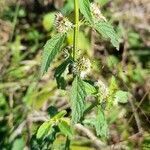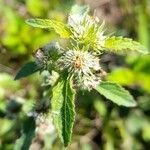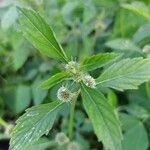Herbs erect, annual. Stems 50-100 cm, angles appressed pilose. Petiole ca. 5 mm; leaf blade ovate-oblong to lanceolate, 5-7 × 1.5-2 cm, adaxially olive green, abaxially greenish, pilose, base narrowly cuneate, margin serrate, apex acuminate. Capitula axillary, ca. 1 cm in diam.; peduncle 0.5-1.6 cm, densely appressed pilose; bracts lanceolate to subulate, 4-6 mm, margin entire. Calyx subcampanulate, 2.5-3 × ca. 1.5 mm, minutely hispid; teeth as long as tube, apex subulate; fruiting calyx dilated. Corolla white, ca. 3.5 mm, puberulent, throat to 1 mm wide; upper lip ca. 0.5 mm, lobes circular, reflexed; middle lobe of lower lip larger, concave, circular, ca. 1 mm, constricted at base, recurved; lateral lobes triangular, reflexed. Stamens slightly exserted. Nutlets dark brown, ovoid, ca. 1 × less than 0.5 mm, adaxially ribbed, with 2 basal white scars.
Erect herb, 0.5-1.5 m, not aromatic. Stem shortly branched, glabrous or pilose. Leaves membranaceous, narrowly lanceolate or ovate-oblong, 4-8 by 1-2.5 cm, acute or acuminate, base long cuneate, entire, margin elsewhere serrate, sparsely hispid on nerves on both surfaces; petiole 0.5-1 cm, hispid. Flowers in dense spurious heads, 0.6-0.8 cm Ø, in fruit 0.8-1.2 cm Ø, on axillary, hispid slender peduncles, 1-1.2 cm long. Subtending bracts lanceolate or subulate, 4-6 mm long, setaceous. Calyx subtubular, 2.5-3 mm long, in fruit 3-4 mm; teeth erect, subulate, 1-1.4 mm long, sparsely ciliate. Corolla white, 3-4 mm long; lips glandular, the lower lip yellowish. Anthers purple. Nutlets ovoid, 0.7 mm long, dark brown, minutely rugose, not swelling when soaked in water.
A herb. It grows each year from seed. It has spindle shaped tubers. The stems are 1-1.5 m high. The angles of the stem are rough. The leaf stalk is 0.3-2.2 cm long. The leaf blade is oval or sword shaped and 2.5-7.5 cm long by 1-2.5 cm wide. It is bluish green. The edges have teeth. It tapers to the tip. Flowers are white. The nutlets are dark brown and oval. They are 1 mm long by 0.5 mm wide.



